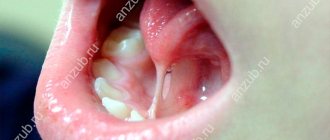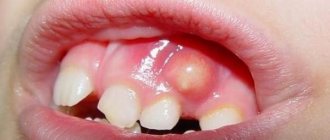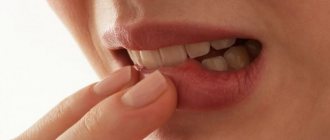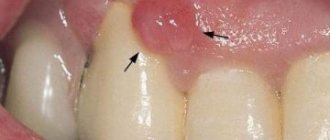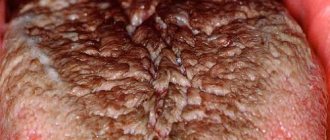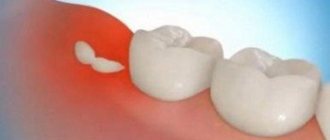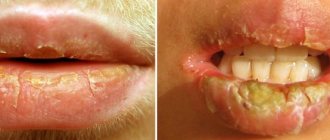Why does it occur
Due to various life situations, suppuration may appear, which is expressed in the form of a popping up ball or a water bubble under the tongue or above it. This may be directly related to both internal and external changes in the body.
Damage to the tongue, or rather to its joint, is the most common cause. This injury can have completely different consequences.
Below we will talk about the three most popular reasons:
- Thermal. If there is a sudden change in temperature while eating or drinking liquid, the tongue may become damaged. Eating food that is too cold or hot will cause irritation. Subsequently, a small bubble or bump may appear on the tongue. Often, it will go away on its own within a few days.
- Mechanical impact. When the mucous surface of the tongue is damaged. This often happens when eating fish meat, which contains quite a lot of sharp bones. It happens that you won’t notice much damage right away, but after a few days a ball will form at the site of the wound. This also includes independent tongue bites.
- Chemical exposure. Increased consumption of salt or various spicy seasonings can also lead to inflammation. The result is inflammation.
The resulting ball can be of completely different consistency. The severity of the injury directly affects this. Often on the first day after damage, a small bump of a light shade or bright red appears.
If in the first option we can say that everything is in order and the vessels are not injured, then in the second it is a clear sign of damage. In this case, it is recommended to contact a specialist.
During the examination, the doctor spends a lot of time on pain, inflammatory tone, its shape and, of course, location. When the gastrointestinal tract is disrupted, the body causes a reaction that can affect the rash of small bubbles on the surface of the tongue.
Ranula
At an early stage, a bubble may appear, which will not bother you at first. This bubble can easily be accidentally burst using your teeth. It contains a clear liquid inside. If you accidentally pierced it, this does not mean that the problem is solved.
Ranula is a chronic pathology and must be carefully treated. This disease is also called a sublingual cyst, and is popularly called a frog tumor. One of the unpleasant aspects is that ranula has relapses.
Today there are many different creams and gels in the pharmacy that can be used to get rid of ranula. But this will only relieve the symptoms, and the real problem must be solved with a specialist. The doctor will prescribe a course and method of treatment.
Hematoma
When you get an injury to a cyst, a red lump forms at this place, which has a painful effect. The obvious sign of a hematoma is redness, because the redness is the result of a blood clot in the injured area. Due to the resulting injury, the cheek may also be damaged.
After damage to the vessels, the hematoma stage begins. At first, only a transparent blister may appear, since the blood has not yet had time to collect inside it or the damage is not significant. If this is the second option, then within a couple of days it should go away on its own. Otherwise, you will need to be examined by a doctor.
The most important thing is to establish the causes of your disease, and then draw some conclusions and begin treatment.
Below we have outlined several main points that your doctor will first pay attention to:
- The exact location of the tumor;
- What color and density is the cone;
- Size;
A tumor can occur as a result of a protective reflex of the body. A blood bubble forms in its place. In the best case, it will pass without surgical intervention, but if five days is not enough to solve this problem, then do not waste time and contact a specialist. He will examine and make the correct diagnosis to avoid dangerous pathology.
For this disease, doctors recommend taking a preventive course, which includes taking minerals and vitamins. You need this to strengthen your blood vessels. The lump is only pierced if it interferes with your eating. Otherwise, this is not recommended.
Read why nylon prostheses are banned in Europe. Why does a rash appear on the oral mucosa in children? The answer is here.
Stomatitis
There are a lot of reasons for the appearance of stomatitis. Often due to your neglect of the oral cavity and teeth. The human mouth is like a bait for bacteria; many different infections get there, to which the body can respond in the form of stomatitis.
It should be noted that the main weapon against this disease is personal hygiene. If you are okay with this, then in most cases this problem will bypass you.
Young children suffer the most because of this, when they put everything they see in their mouths. If we take the statistics of this disease, then every fifth person suffers from this disease.
Below are a number of other reasons why stomatitis may appear:
- Sharp teeth that rub the tongue and cause irritation;
- Intestinal function is disrupted;
- Women have an unstable metabolism during pregnancy;
- Having a cold or flu;
- The appearance of worms in the body;
- Lack of vitamins in the body;
- Excessive consumption of alcohol and tobacco products.
Having read the causes of the disease given above, we can say that no one is immune from this problem. Therefore, take care of yourself and do not make stupid mistakes.
Stomatitis appears on the surface of the tongue and looks like a small bump with a dent in the middle. At the beginning it has an unpleasant effect in the form of itching and burning. The small tumor has a grayish tint and causes great inconvenience when eating and talking.
Also, this disease has relapses, so it is necessary to be treated at an early stage of the disease. If you do not consult a doctor about this problem in time, you will face complications in the future.
Diagnostics
To diagnose the anomaly, you must visit a dental office. Based on the patient’s complaints, the doctor will prescribe additional laboratory and instrumental tests.
It happens that ranula is diagnosed accidentally during a visit to the dentist, otolaryngologist, or by the patient himself. Usually a person is not aware of the tumor until it reaches a large size or is injured.
Diagnostic methods to identify sublingual cystic formation:
- ultrasound examination of the salivary glands;
- computed tomography or magnetic resonance imaging;
- X-ray examination of the salivary ducts;
- contrast x-ray;
- biopsy sampling.
Thanks to instrumental diagnostic methods, it is possible to accurately determine the location of the ranula, its size, and the depth of penetration into the tissue. Benignity or malignancy will be confirmed by histological examination. The contents of the capsule are aspirated with a thin needle. The material is sent for histology after puncture of the cyst shell or after surgery to remove the cavity.
Other signs
The most common reasons for the appearance of a lump on the surface of the tongue are the above diseases: hematoma, stomatitis and ranula, but in addition to these diseases there are a number of others.
Below we list the main reasons:
- Lipoma. A rounded flat shape appears on the tongue. Often located slightly further than the middle of the tongue. Quite a rare disease. At the beginning there are no painful effects, but over time the lump can grow several times larger and discomfort in the oral cavity will be felt. You won't be able to remove a lipoma on your own. This will require the help of a specialist.
- Papilloma. A lump that appears on absolutely any part of the tongue and has a grayish light gray tint. This disease is transmitted through sexual intercourse, excessive consumption of alcohol, tobacco products, and also due to stress.
- True pemphigus. Not uncommon in infants. The main symptom of this serious disease is many small blisters on the surface of the mucous membrane of the tongue. This disease can be transmitted from mother to child, as well as due to disorders of the autoimmune system.
Treatment
After making a diagnosis, the doctor prescribes treatment measures appropriate to the pathology. Hemangioma in children does not require special treatment. If it grows rapidly, it is removed surgically. Several groups of drugs are used to treat pemphigus:
- Glucocorticosteroids: dexamethasone, prednisolone, etc. They restore the function of the immune system, reduce inflammation, and reduce the manifestation of allergic reactions.
- Cytostatics are prescribed as drugs that protect the mucous membrane.
- Antibacterial drugs.
- Vitamins are prescribed for general strengthening of the body.
Any tumor formation requires surgical intervention. Removing ranula is a very responsible process. If the operation is performed incorrectly, there is a risk of damage to the salivary gland ducts. A cystostomy is performed - removal of the upper membrane of the ranula. The bottom of the cyst remains in the sublingual area, then it degenerates into ordinary mucosa.
Treatment of cones of infectious origin is aimed at treating the underlying cause . For herpes, antiviral drugs are prescribed: acyclovir and its derivatives. Candidiasis is treated with antifungal drugs: Clotrimazole, Fluconazole, etc.
The inflammatory disease glossitis requires the prescription of anti-inflammatory and antibacterial drugs. When syphilis is detected, broad-spectrum antibiotics from the group of penicillins, macrolides, and tetracyclines are prescribed.
Aphthous stomatitis is treated by rinsing and irrigating the oral cavity with antiseptic solutions: decoctions of chamomile, calendula, and Stomatidin is used for irrigation. Additionally, physiotherapy is prescribed. To treat vitamin deficiency, a course of vitamin therapy is prescribed, and the diet is adjusted. Food should be as fortified and balanced as possible.
Detection of endocrine diseases is not complete without hormone therapy . The endocrinologist selects the necessary medications according to the type of endocrine disorder. Blisters caused by injury usually go away on their own. To quickly restore the mucous membrane, you can rinse the mouth with decoctions of chamomile, yarrow, calendula, and sage. Aloe juice has a wound-healing effect and can be used to lubricate wounds.
Symptoms of a ball appearing under the tongue
Below are the symptoms by which you can independently determine whether a given lump (under or above the tongue) is a cyst:
- The area under the tongue is inflamed;
- Noticed a transparent water bubble;
- Also, this bubble may have a tint of blue;
- It is easy to burst or crush;
- After it bursts, another one appears in the same place.

